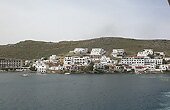 |
 |
 |
Arrivals – Departures |
|
 |
Athens International Airport – Eleftherios Venizelos |
|
|
 |
 |
 |
|
 |
 |
 |
Better check the weather... |
|
 National Observatory of Athens National Observatory of Athens |
 Poseidon Poseidon |
 Ntua.gr Ntua.gr |
 Accuweather Accuweather |
 Weather Underground Weather Underground |
|
|
 |
 |
 |
|
|
|
 |
 |
| Merichas |
  |
|
|
|
 With 200 residents, it is located west, 7km from Hora and is the port of the island.
Upon arriving at Meriha, you will be reminded of a large amphitheatre observing the calm sea, which it affectionately embraces. The dry hill discreetly decorates with the white and blue tones of the Cycladic style. The town extends out with all kinds of stores (Restaurants, tavernas, super market, bakery, cafeterias, bars etc) along the edge of the port, and ends in a pretty beach decorated with salt hills.
If you are interested in the history of the island then it’s worth taking a trip to visit Vryocastro, the ancient capital of the island. The town was inhabited from the 10th century BC until 7th century AD, when the residents moved to the town, Kastro for their protection from the invaders. The area remains full of ancient artifacts - ruined walls, temple structures and altars, traces of ancient markets from the Roman age and so on. The relics of a small jail have also been saved, believed to be the seat of the garrison of Phillip of Macedonia. Another interesting characteristic are the three caves that collect the water of the town.
Check out the church of the Panagia of Flambourianis.
The islet of Agio Louka at Kolono, which exists as a natural refuge for yachts and sailboats is a lovely sight.
Swim in the beach in town, or at Martinakia, a short distance away, a beautiful sandy beach right at your feet for those not keen on exploring the surrounding area.
Another couple of sheltered beaches to visit are Episkopis and Apokrousis. |
| |
| Worth seeing |
•If you are interested in the history of the island then it is worth taking a trip to visit Vryocastro, the ancient capital of the island. The town was inhabited from the 10th century BC until 7th century AD, when the residents moved to the town, Kastro for their protection from the invaders. The area remains full of ancient artifacts - ruined walls, temple structures and altars, traces of ancient markets from the Roman age and so on. The relics of a small jail have also been saved, believed to be the seat of the garrison of Phillip of Macedonia.
•Another interesting characteristic are the three caves that collect the water of the town.
•Check out the church of the Panagia of Flambourianis.
•The islet of Agio Louka at Kolono, which exists as a natural refuge for yachts and sailboats is a lovely sight. |
| |
| Where to swim |
|
|
|
|
|
|
 |
 |
|
|
|
 |
 |
 |
|
|
|
 |
 |
|
|


